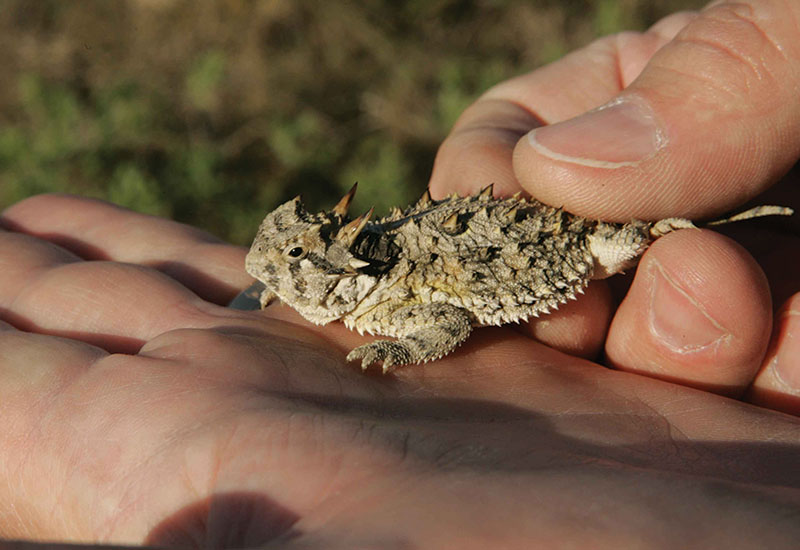Known more popularly as a “horned toad,” “horny toad,” or “horned frog,” the Texas Horned Lizard is neither. They are not amphibians, like other toads, but instead are reptiles with claws and scales. Their appearance has a long heritage within Texas history and prehistory. Some Native American tribes revered horned lizards as sacred animals. Throughout the Southwestern United States and into Mexico, the lizard was a common motif in Native American artwork. This reverence has continued to the present-day. The “horned frog” is the mascot of Texas Christian University in Fort Worth and can be found in the university’s seal. In 1993, the Texas Horned Lizard was designated as the Texas state reptile.
Their wide, flat bodies give the lizard a decidedly toad- or frog-like appearance, leading to their misgiven nicknames. There are three species of horned lizards in Texas: the Round-tailed Horned Lizard; the Greater Short-horned Lizard; and the state lizard, the Texas horned lizard (Phrynosoma cornutum). Endemic to North America, the Texas horned lizard can be found in south-central regions of the United States and northeastern Mexico. They can be found throughout most of Texas but have nearly disappeared from the eastern third of the state. The largest-bodied, and most widely distributed, of the 21 species of horned lizards, they are easily identifiable and can be found from sea level at the coast to the more mountainous spaces in the western part of the state.
The Different Species of Horned Lizard Found in Texas

Greater Short-Horned Lizard

Round-Tailed Horned Lizard

Texas-Horned Lizard
One of the most characteristic features of the Texas horned lizard are their distinctive horns, which lend to their name. The two largest horns crown the lizard’s head, along with two more on both its brows and jawline. Spikes line the lateral parts of the lizard’s torso and ridges along its back. Like many of its contemporaries, this lizard’s coloration allows it to blend with its environment. Those found in the prairies are likely to be a light brown color while those in the desert range from yellow to rust-like to get lost in the sand. Additionally, dark lines span from their eyes to the tip of their horns and a very characteristic solid white line, accompanied by black circular splotches.
While their appearance in the wild might seem dangerous, the Texas horned lizard is a very docile animal. They are sunbathers and can often be found in open and rocky areas and along the sides of roads, lounging in the sun. Also, they can be found near harvester ant colonies for meals, and rarely move beyond 50 meters (roughly 164 feet) of that site. They are good diggers, burying themselves in sand and dirt at night to sleep and hibernating under the ground during the winter – typically from October to March. Fairly sedentary, they do move quickly and have self-preservation mechanisms to avoid predators. Their coloration helps keep them concealed; their appearance scares off some predators; they can inflate their bodies to give a much larger apparent size; and, finally, they are renowned for its ability to shoot a stream of blood from its eyelid.

Unfortunately, the Texas horned lizard’s population has been declining and the lizard is currently a protected species. Their habitat has been eroded or encroached upon by about 30%. This has come through overuse of pesticides, imported fire ants that also rely on harvester ant colonies, and development. In Texas, it is illegal to take, transport, possess, or sell a Texas horned lizard without a special permit.
Horned lizard research and conservation efforts have increased in recent years along with successes in captive breeding and reintroduction. Participants in these efforts include the Texas Parks & Wildlife Department along with Texas Christian University and the Fort Worth, Dallas, San Antonio and Houston Zoos. Texan by Nature, founded by Former First Lady of the United States Mrs. Laura Bush, and the Horned Lizard Conservation Society are two non-profit organizations actively engaged in horned lizard conservation. Of note, the Fort Worth Zoo was the first zoo to successfully breed Texas horned lizards and since 2011 has reintroduced over 500 lizards in the wild.









